How to properly plant thuja in the country. The most famous varieties of thuja. Coniferous fencing
Thuja is one of the most versatile and attractive trees or shrubs you can find in the garden. They are very useful for creating hedges and look great in containers and as accents in the garden. Planting a green wall of thuja will provide noise and dust protection and a beautiful backdrop near the house.
They are one of the easiest evergreens to grow and come in such a wide variety of sizes, shapes and colors that they can suit any landscape. By following a few simple tips for growing thuja, you can admire this plant in your garden.
Wide selection different varieties and forms of thuja are in. Qualified specialists will introduce you to the assortment, deliver and plant thujas on your site!
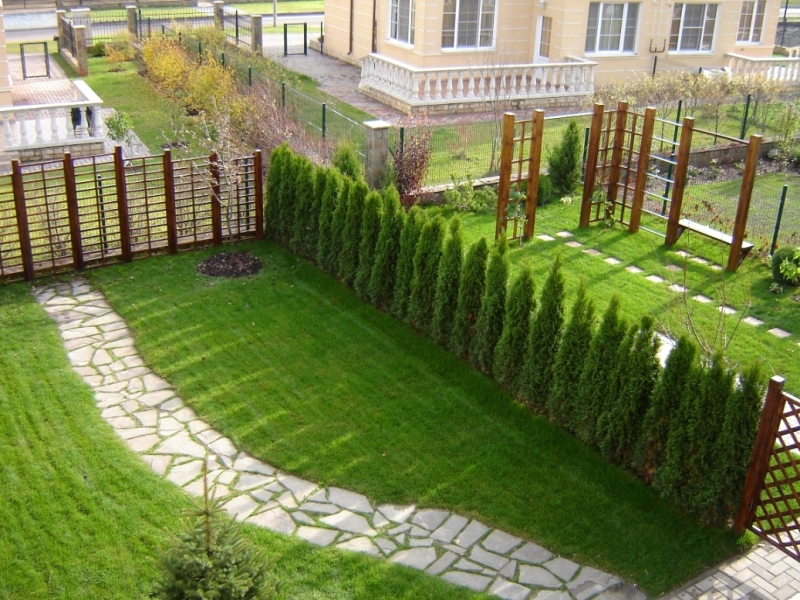
Conditions for growing thuja.
Thuja prefers places with moist, well-drained soil in sun or even partial shade. Before planting, check drainage and add sand to the soil if the soil in your area retains too much moisture.
Thuja needs a soil pH level of 6.0 to 8.0. Sufficient quantity organic material in the soil will improve its structure and level nutrients.

The best time to plant thuja on the site.
Most evergreens, such as thuja, are planted when they are in their dormant growth phase. Depending on where you live, thuja can be planted starting in early spring when the ground thaws.
Thujas are usually sold with a closed root system, protected from mechanical damage, which allows you to be more free in choosing the time of planting than in the case of plants with an open root system. If spring planting for some reason is impossible, it is also permissible to plant thuja in the fall, covering the soil around with a thick layer of bark or organic mulch.
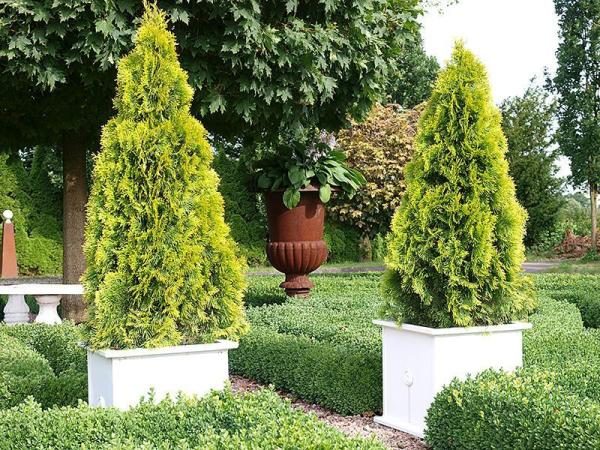
How to plant thuja?
The most basic issues when planting thuja are the location and condition of the soil. These plants have an extensive root system close to the surface. Dig a hole twice as wide and deep as the root ball to give the roots room to spread. Water frequently for the first few months, then gradually reduce watering. Make sure that in hot weather summer days the soil does not dry out. 
Caring for thuja is as easy as shelling pears!
Thuja is a very hardy plant that does not require care. It does not require special pruning and naturally takes on an elegant pyramidal shape. Insect pests may appear; in hot, dry weather, damage is common spider mite. Good watering and foliar spraying can minimize the presence of these pests.
A layer of mulch of about 5-10 cm should be applied around the base of the trunk, and light fertilizer can be applied in the spring.
Thuja will fully reward even novice gardeners with its low maintenance requirements and fast growth.
Do a KIND SHARE this page on social media. networks
Classmates
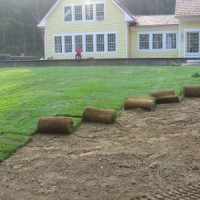 Installation recommendations roll lawn
Installation recommendations roll lawn
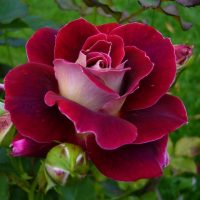 6 Tips for Growing Roses in Cold Climates.
6 Tips for Growing Roses in Cold Climates.
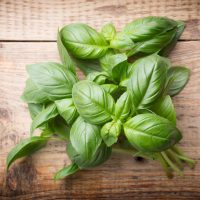 Basil - Tips for easily growing aromatic herbs.
Basil - Tips for easily growing aromatic herbs.
They do not differ in variety, most often these are fruit varieties, but you should not stop there. This article will talk about thuja, which differs from pines and spruces in its leaves, which resemble flat scales rather than needles.
This conifer most in demand at suburban areas, as it is able to fill its atmosphere with a wonderful healing aroma.
For its appearance, the thuja received the second name “royal tree” and, despite its “high” status, caring for it is quite simple. By the way, planting a tree is also not difficult, thanks to which many gardeners cope with this task with their own hands, even without experience.
Species
Today there are hundreds of varieties of thuja, although there are only five species. In our country, the most popular is “thuja occidentalis”, which came to us from North America, having previously conquered the Old World.

The plant can be found everywhere, with the exception of the regions of the far north and semi-deserts. Appearance resembles a shrub or tree, depending on the variety, and rarely grows more than 2 m.
A characteristic feature of thuja is:
- compact crown, which can be columnar, pyramidal, spherical or weeping;
- slightly reddish trunk;
- small bumps.
Advice: country houses from block containers go well with the thuja on the site.
In winter, the bright green needles turn brown. In addition, there are red and variegated shades.
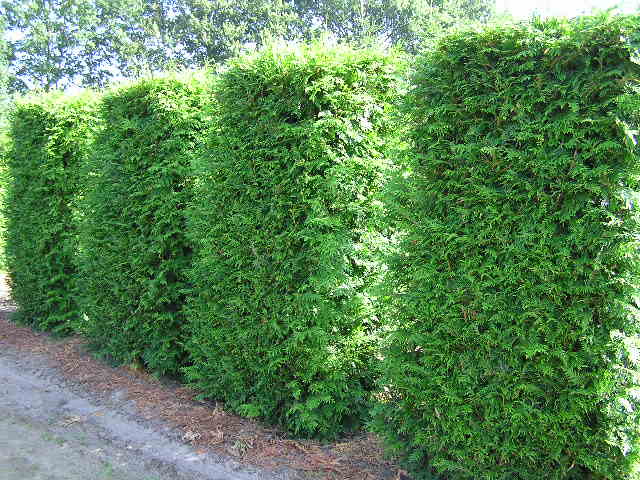
Below are the most common varieties of western thuja:
| Brabant |
|
| Emerald |
|
| Hosery |
|
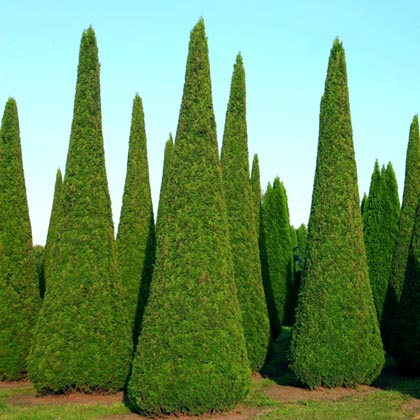
Growing
Let's consider below how to grow thuja in the country.
There are three main ways to get it on your site:
- grow from seeds;
- use propagation by cuttings;
- buy a ready-made seedling.
Let's take a closer look:
- The longest method is growing from a seed; it is not popular due to the fact that it will take 5 years to wait for a full-fledged seedling; in addition, only a wild tree will appear from any cone. Alas, varietal characteristics in this case are transmitted very rarely. However, there is an undoubted advantage of the method - the seedling will be perfectly adapted to local conditions.
![]()
- A more effective option is to use cuttings for propagation, and it also leads to quick results. The good thing is that you will get a high-quality tree.
The instructions are as follows:
- Take in spring shoots 2-3 years old, 300 mm long, or annual shoots, 150 mm long. Please note that after separation there was a piece of wood left at their end;
Advice: carry out the work early in the morning or on a cloudy day. Please note that shoots from the top of the plant better inherit their parental properties.
- soak the cuttings in a solution of potassium permanganate to disinfect them;
- bury the cuttings in nutrient soil, where there is a little peat, 50 mm at a certain angle, shade and support high humidity.
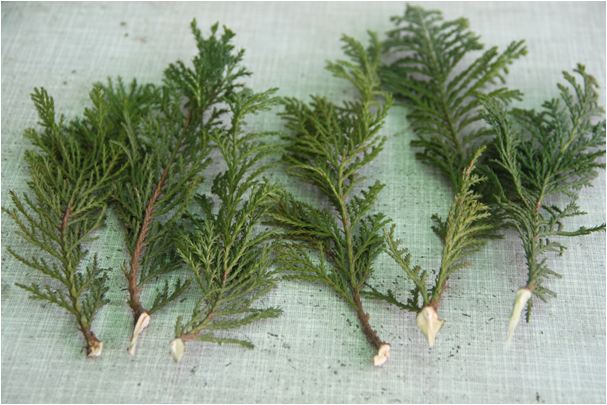
It is recommended to do this in a greenhouse, as it is easier to maintain comfortable conditions there. Usually, by autumn the cuttings take root well, so cover them well for the winter, and prepare those plants that have successfully overwintered for replanting.
- Purchasing ready-made seedlings is a simple, reliable, but most expensive growing option. It should be taken into account that if you do not know which fast-growing thujas to choose for your garden, a reliable way would be to buy them from a professional nursery. In other cases, it will be a risky endeavor, since you will not have a guarantee that you purchased the right variety of plant. The price of the seedling in this case will be higher than the previous ones.
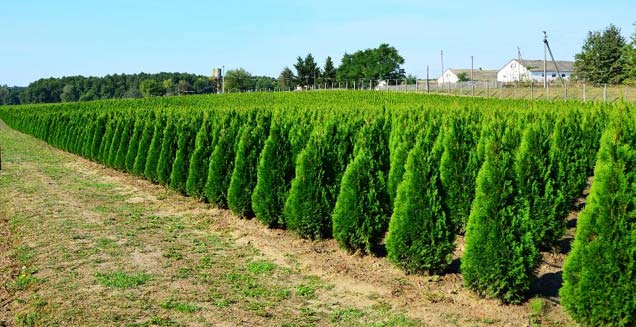
Advice: if you don’t know where to plant thuja in the country, choose slightly shaded places sheltered from the wind.
- carefully inspect the seedling, so as not to lose money, buy only the best specimens;
- the soil in which it was located should not be dry. This will tell you how long the seedling has stood like this; maybe nothing will help it;
- on a young thuja the needles do not fall off;
- the plant should not show signs of disease.
Advice: although young trees take longer to grow, they adapt and take root more easily.
How to care
The main thing for thuja is correct landing and care.
You will need to water the plants regularly:
- during normal weather - once a week;
- if it is dry and hot - 2 times a week.
Mature plants also need watering, otherwise the soil under them will dry out and you will not get the juicy shade of pine needles. The top will also begin to gradually turn yellow. Due to drought, a large number of cones will appear on the plant, which will also spoil its decorative appearance.

Watering should be done early in the morning or evening so that the water has time to be absorbed and the “foliage” has time to dry. Don’t forget also about sprinkling - another important procedure that helps transform the thuja right before your eyes. It should be carried out simultaneously with watering.
You will immediately notice how the needles become refreshed and clean, and the air begins to fill with aroma. If you manage to irrigate the crown often, maybe twice a day, the tree will look perfect.
Advice: you don’t want to wait for repairs to be made or electricity to be supplied to your house, renting a diesel generator for your dacha will help you.
Additional work
Not only watering is necessary to care for thuja, you will also need mulching, loosening the soil, fertilizing it and pruning it.
- Be sure to loosen the tree trunk circle, having previously cleared it of weeds. However, remember that the roots of the plant are located close to the surface of the soil, so work should be carried out shallowly.
It is generally recommended to cover it with mulch, for example, compost or sawdust, colored wood chips or nut shells. This way you can keep the soil moist, suppress weeds and protect the roots in winter.

- Feeding the plant is necessary to give it greater decorativeness and durability in winter period. However, it is enough to do this once at the beginning of the season.
It is best to use special fertilizers and compost for. Remember, excessive feeding will lead to large growth of the thuja, which will affect the time of its pruning.
- 2 years after planting, the plant must be pruned to give it the desired shape. Thuja easily tolerates molding, but remember that shoots can be shortened by no more than 1/3. It is best to use a powerful and large pruner that does not leave dents on the branches.
The crown can be shaped like a ball, column, pyramid or other shape. With the help of shearing, you can maintain high grades at the desired level.
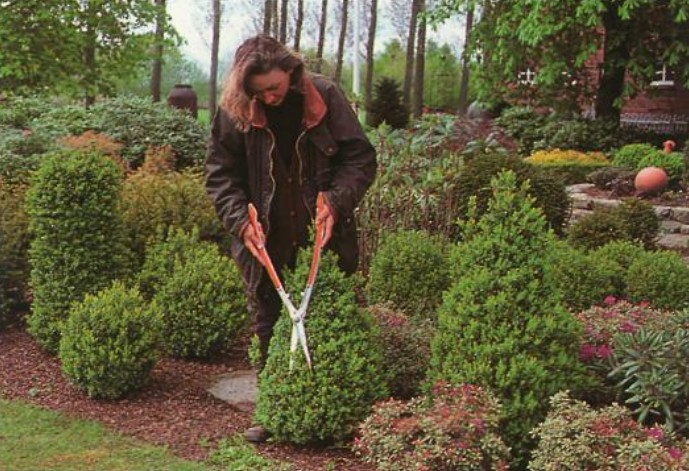
Advice: perform pruning twice a season - at the beginning of summer and closer to autumn, and do not forget to remove all dry branches.
Conclusion
Although most of us try to plant fruit trees, you can allocate part of the territory for thuja. The healing aroma of its needles can improve your health just as well as its fruits. The main thing is to choose the right seedling, plant it and organize its care.
The video in this article will help you find additional information on this topic.
Modern landscape design is rich in a variety of types of coniferous plants. The aroma of country air, saturated with pine needles, is a pleasant and healthy frame for relaxation in the countryside and in the garden. Plants are used in the landscape to create beautiful compositions, flower beds, rockeries and topiary, as well as in the form of fences. Coniferous trees in landscape design get along well with deciduous trees and look great on lawns framed by stones and flowers. Plants are distinguished by a variety of species of different shades, shapes and sizes, plus - a unique decor all year round.
Options for using conifers in the landscape.
Decorative types of conifers are popular in design solutions landscape due to its unique properties:
- Coniferous trees and shrubs are frost-resistant, easily survive severe cold, adding decor to the winter landscape;
- Thanks to their powerful roots, coniferous plants provide themselves with moisture even in dry summers, so they do not require frequent watering;
- conifers develop well in low light conditions and grow in shade and partial shade;
- trees are attractive at any stage of their life. As they grow, the beauty and density of their crown only intensifies;
- The diversity of conifer species implies the presence of compact forms that do not require special care.
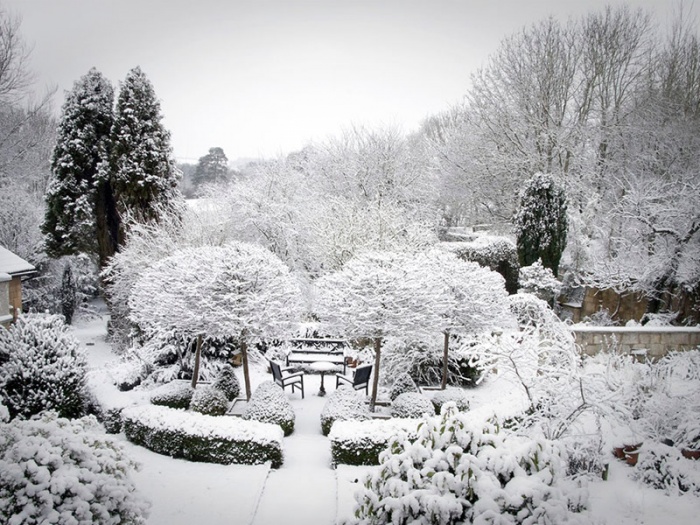
Coniferous plant cultures can be used when planning landscape compositions in any style. Trees miniature forms appropriate in green fences, flower beds and rockeries.
Coniferous rock garden design
An ornamental garden on a gentle slope with scattered stones, a variety of unpretentious flowers, shrubs and miniature conifers is a rockery. When creating a semi-wild coniferous landscape, you need to follow some principles:
- dwarf representatives of coniferous species are chosen as the basis for compositional vegetation;
- when choosing types of coniferous plants, their unpretentiousness is taken into account;
- when forming a rock garden there should be no pronounced differences in terrain;
- the plot pattern is created by a combination of large stone and gravel backfill.
Before purchasing seedlings for a rock garden, you need to think about the composition landscape design, miniatures of conifers are not cheap in price. You can achieve the best effect in the compositional design of the landscape by choosing a vertical coniferous dwarf for the dominant plant, with a crown in the form of a cone or oval. The dominant plant is planted at the beginning or middle of the composition; small seedlings with a spherical crown are placed around it. Planting creeping ground cover conifers will serve as a background.
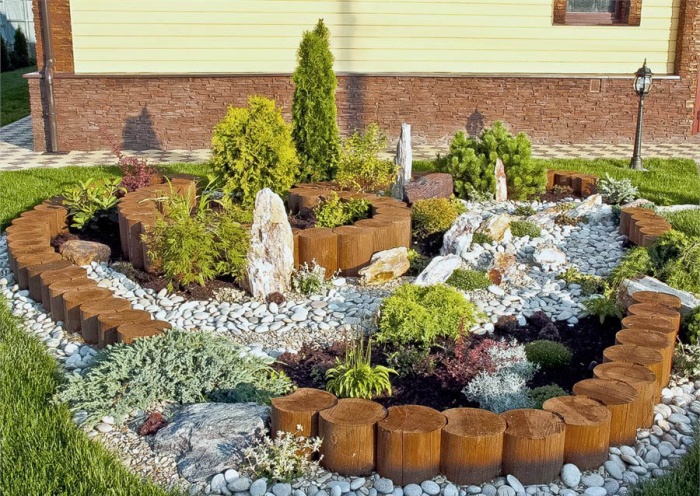
An alpine slide differs from a rock garden in requiring more sunlight. A gently sloping garden of conifers is unpretentious in this regard and looks wonderful in a landscape design under the windows of the estate, in the shade of a gazebo, on the shore of an artificial pond.
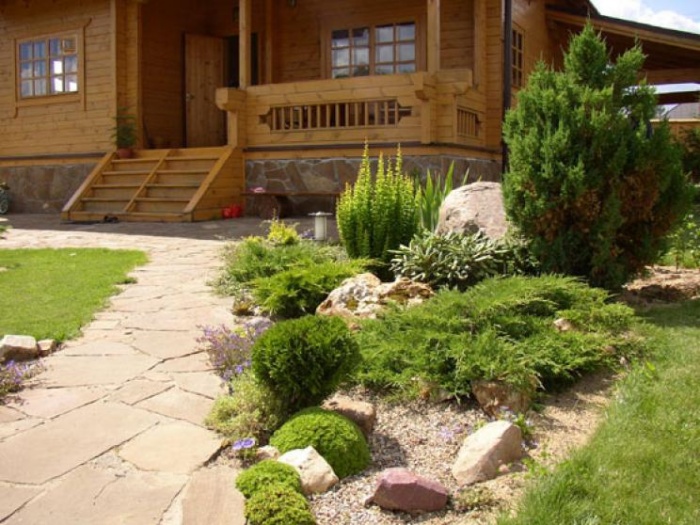
When creating a rock garden, you should not overload it with variety coniferous species, you can lose the beauty and uniqueness of everyone. When composing groups, it is better to use contrasts in the shape and color of trees or apply the aesthetics of a smooth transition.
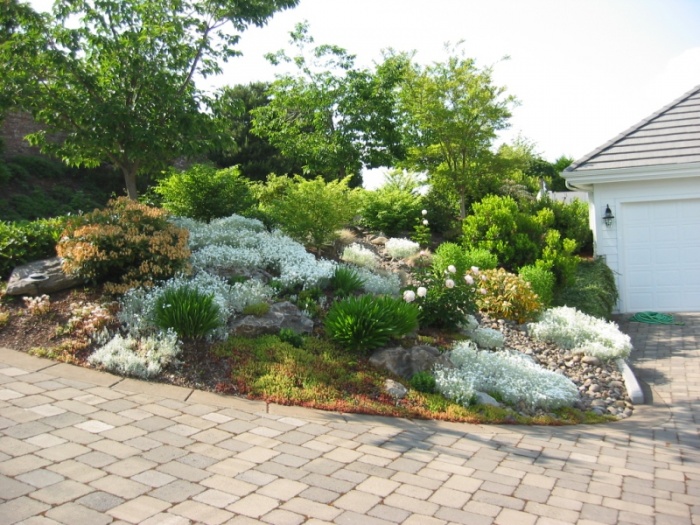
Wild stones, as elements of landscape design, should be organically included in the composition and not hidden in coniferous thickets, but harmoniously placed among dwarfs of spruce, pine, thuja and juniper. The result should be a complete illusion of a natural landscape in miniature. The slow growth of conifers (up to 3 cm per year) will allow you to preserve the composition for a long time.
Design of flower beds from conifers
In the landscape design of a summer cottage, coniferous species look great in flower beds. Their sizes and design depend on the size personal plot and gardening talent.
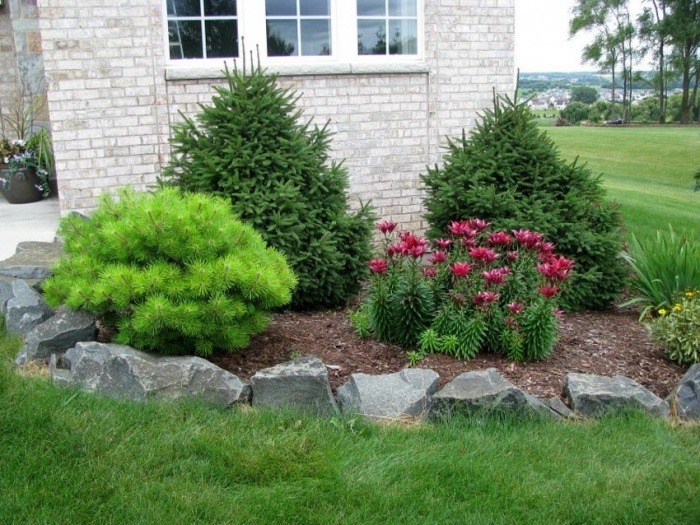
There are several main types:
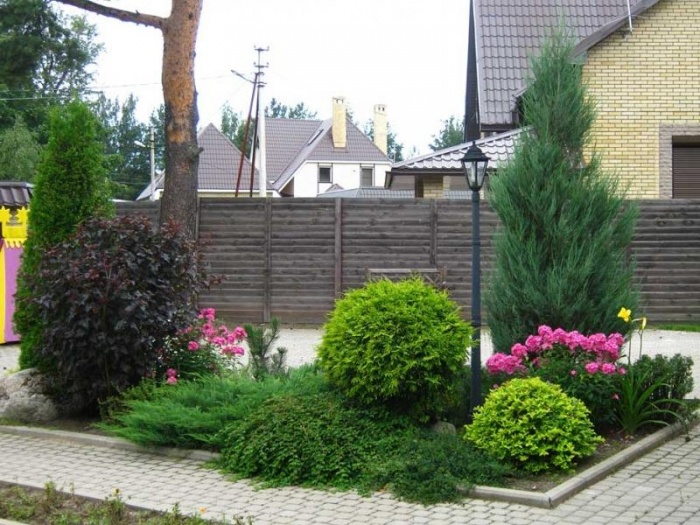
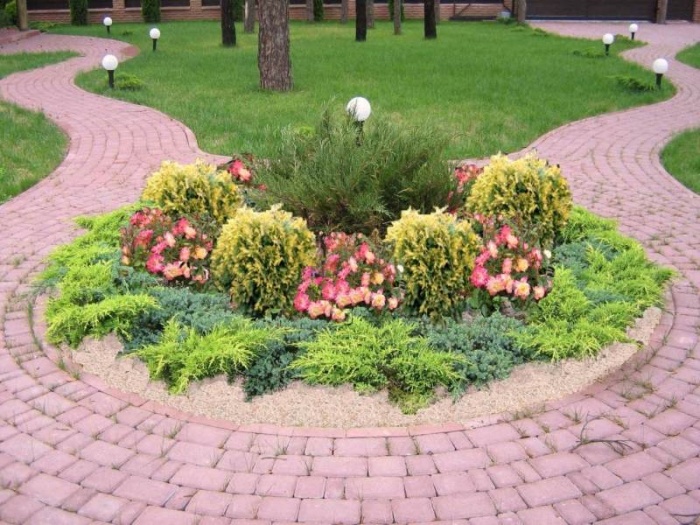
Attention! When designing a flower bed, the amount of free space for the growth and development of green perennials is taken into account.
Arrangement coniferous flower bed is not particularly difficult. With the correct selection of the species range of evergreens and their proper placement, you will get beautiful view adjoining area with minimal waste of time and effort.
Coniferous fencing
Conifers in the landscape design of a summer cottage add a certain majesty to the landscape composition, especially evergreen plantings in hedges. A fence made of coniferous trees can be of different heights and has strict beauty and harmony. In addition to decoration, a plant fence also provides useful functionality:
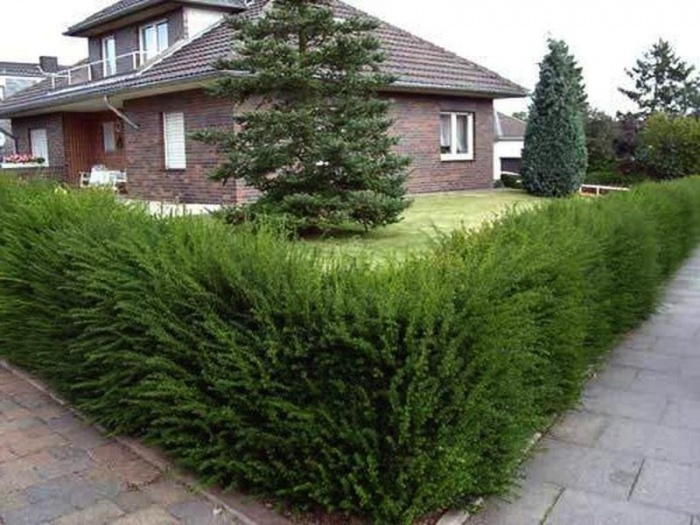
It is better to buy types of trees and shrubs for living fencing in a special nursery, but can be found in ordinary flower shop. Some coniferous species are suitable for propagation by cuttings or seeds.
Mastery of complex design
Conifers in landscape design open up space for the flight of imagination. The art of topiary can give a plant any fantasy shape. The main way to obtain a shaped variety of plants is pruning; types of yew, spruce and juniper are used. Creating simple shapes- cylindrical, spherical, cone-shaped, it is better to choose those types of conifers whose crown will suffer minimal damage.
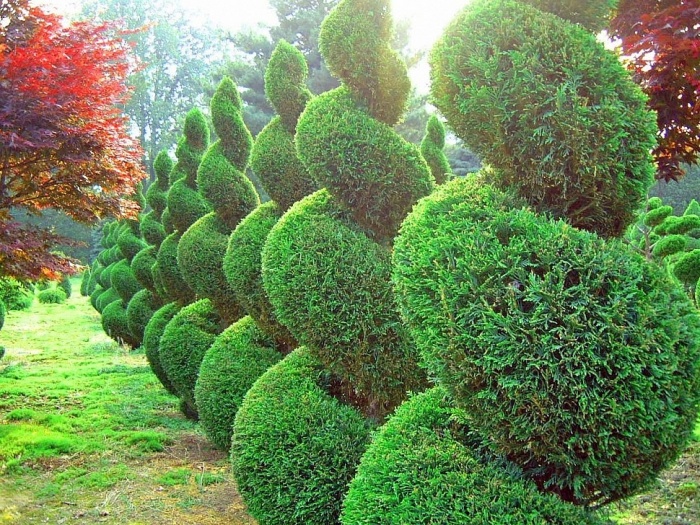
Experienced gardeners trim trees by eye; for beginners, there are stencils and various devices in the form of driven pegs and stretched ropes. A novice amateur gardener can give the crown of an ephedra a beautiful, spiral shape. Using a wide ribbon you need to wrap young tree with a conical crown and cut off all branches from free areas. After a year, the clipped areas are already clearly visible, you can correct them a little and the end result is a beautiful sea shell.
Choosing a garden plot design
The high decorative value of conifers opens up a wide range of applications in landscape design. It is necessary to preserve the beauty and uniqueness of each coniferous tree, so there is no need to plant an entire forest.
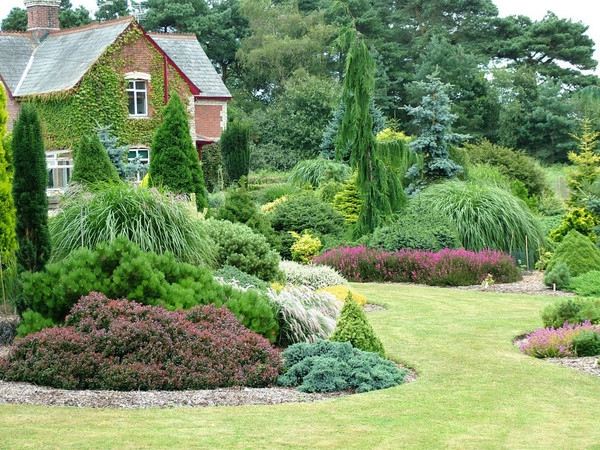
Before planting plants, be sure to consider:
- climatic conditions;
- terrain;
- dimensions of the plot and yard buildings;
- the presence of ponds and bridges.
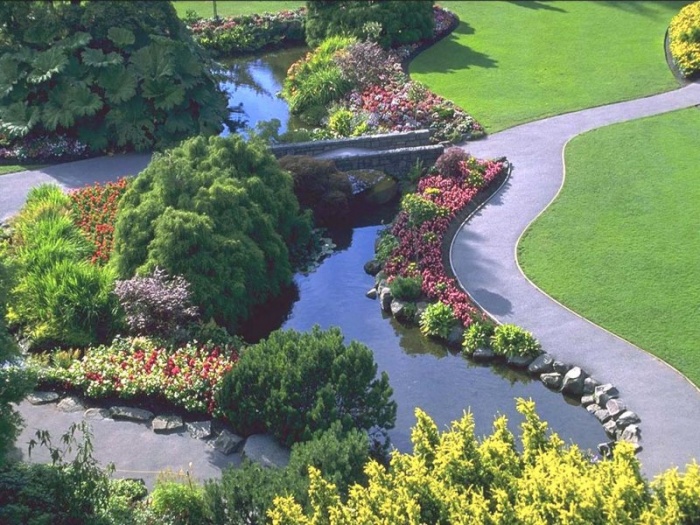
All this must be linked with each other and coniferous perennials. You need to carefully consider the compositional design solution country garden, when replanting grown trees, the root system can be damaged.
Combination of plants in a coniferous garden
When developing garden landscape design special attention is paid to the compatibility of plant crops:
- Fir and spruce are not planted near cedar and pine;
- spruce and thuja are unwanted neighbors;
- larch needs to be planted separately; the presence of any conifers is intolerable for it;
- the location of birch and bird cherry trees next to coniferous plants negatively affects the latter due to the lack of nutrients in the soil absorbed by deciduous plants;
- bushes blooming roses spectacular with a background of fir and spruce, however, this neighborhood is dangerous for delicate flowers due to acidification of the soil by conifers.
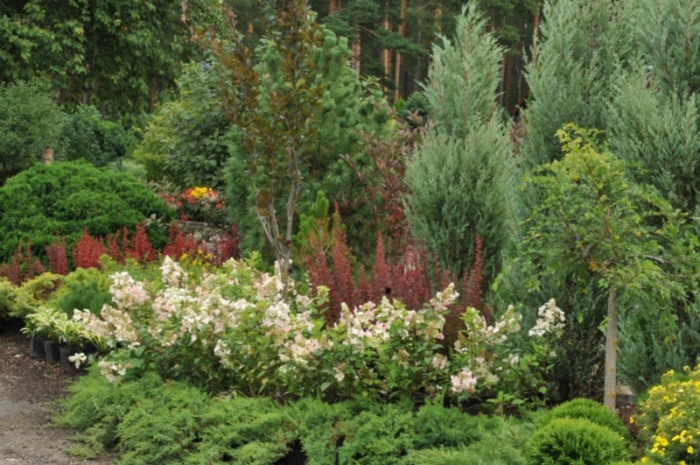
Coniferous plants good neighbors deciduous shrubs, cereals, flower perennials (especially lilies). Shrub species of conifers look colorful in the company of weeping willows near a pond. Thujas with bright greenery and bluish tinted needles will be an excellent background for junipers.
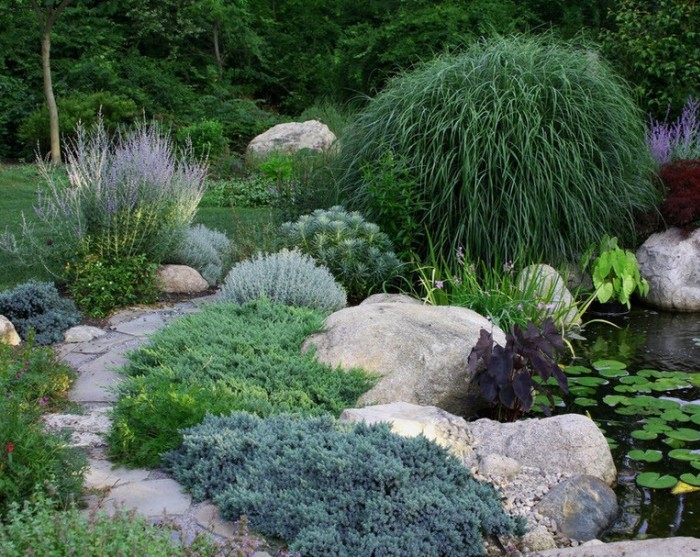
For a spectacular and harmonious look coniferous composition in the landscape, you need to follow some rules:
- conifers look perfect against the backdrop of a smooth and well-groomed lawn;
- for the most advantageous view, the composition of coniferous plants should be removed from the main viewing location by a length of 2 - 3 times its height;
- the compositional solution should be oriented towards the eastern or western direction;
- a contrasting combination of height and color of coniferous species is selected, for example, low, globular species thuja against the background of pyramidal conifers. By playing with the height of trees you can achieve and visual effect- medium-sized thuja or fir next to a low-growing one mountain pine will look quite significant.
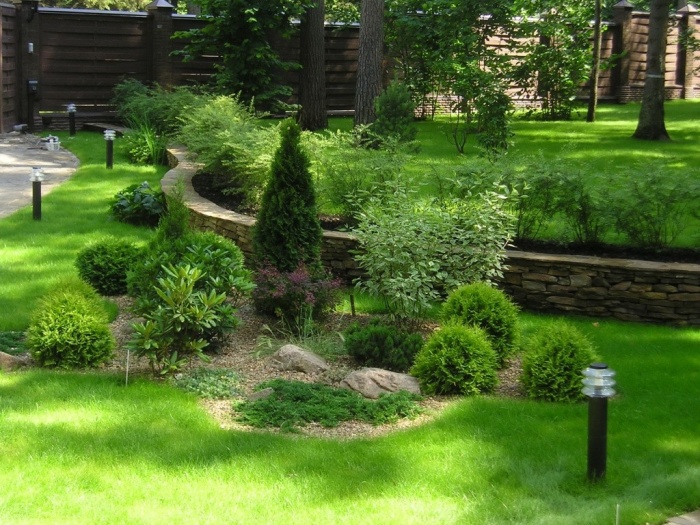
Important! When solving a compositional problem with conifers, one should not forget about their intensive growth in width.
Bottom line
Anyone can improve a piece of land adjacent to their home. A little imagination, bold design experiments with coniferous specimens and the results will bring joy, if you take into account the few rules described above.
The trees at the dacha are not very diverse; most often they are fruit varieties, but you shouldn’t stop there. This article will talk about thuja, which differs from pines and spruces in its leaves, which resemble not needles, but flat scales. This coniferous species is most in demand in suburban areas, as it can fill its atmosphere with a wonderful healing aroma. In the photo - thuja occidentalis on a summer cottage Due to its appearance, the thuja received the second name “royal tree” and, despite its “high” status, caring for it is quite simple. By the way, planting a tree is also not difficult, thanks to which many gardeners cope with this task with their own hands, even without experience.
Species
Today there are hundreds of varieties of thuja, although there are only five species. In our country, the most popular is “thuja occidentalis”, which came to us from North America, having previously conquered the Old World. The plant can be found everywhere, with the exception of the regions of the far north and semi-deserts. The appearance resembles a shrub or tree, depending on the variety, and rarely grows more than 2 m. A characteristic feature of the thuja is:
- compact crown, which can be columnar, pyramidal, spherical or weeping; slightly reddish trunk;
Tip: country houses made from block containers go well with thuja on the site. In winter, the bright green needles turn brown. In addition, there are red and variegated shades. Hedge from the Brabant variety Below are the most common varieties of thuja occidentalis:
Smaragd is a tall plant variety. Let's look below at how to grow thuja in the country. There are three main ways to get it on your site:
- grow from seeds; buy a ready-made seedling.
- The longest method is growing from a seed; it is not popular due to the fact that it will take 5 years to wait for a full-fledged seedling; in addition, only a wild tree will appear from any cone. Alas, varietal characteristics in this case are transmitted very rarely. However, there is an undoubted advantage of the method - the seedling will be perfectly adapted to local conditions.
- A more effective option is to use cuttings for propagation, and it also leads to quick results. The good thing is that you will get a high-quality tree.
- Take in spring shoots 2-3 years old, 300 mm long, or annual shoots, 150 mm long. Please note that after separation there was a piece of wood left at their end;
Advice: carry out the work early in the morning or on a cloudy day. Please note that shoots from the top of the plant better inherit their parental properties.
- soak the cuttings in a solution of potassium permanganate to disinfect them; bury the cuttings in nutrient soil, where there is a little peat, 50 mm at a certain angle, shade and maintain high humidity.
It is recommended to do this in a greenhouse, as it is easier to maintain comfortable conditions there. Usually, by autumn the cuttings take root well, so cover them well for the winter, and prepare those plants that have successfully overwintered for replanting.
- Purchasing ready-made seedlings is a simple, reliable, but most expensive growing option. It should be taken into account that if you do not know which fast-growing thujas to choose for your garden, a reliable way would be to buy them from a professional nursery. In other cases, it will be a risky endeavor, since you will not have a guarantee that you purchased the right variety of plant. The price of the seedling in this case will be higher than the previous ones.
Advice: if you don’t know where to plant thuja in the country, choose slightly shaded places sheltered from the wind.
- carefully inspect the seedling, so as not to lose money, buy only the best specimens; the soil in which it was located should not be dry. This will indicate how long the seedling has stood like this, maybe nothing will help it; the needles on a young thuja do not fall off; the plant should not show signs of disease.
Advice: although young trees take longer to grow, they adapt and take root more easily.
Planting thuja
How to care
The main thing for thuja is proper planting and care. You will need to water the plants regularly:
- during normal weather - once a week; if it is dry and hot - 2 times a week.
Mature plants also need watering, otherwise the soil under them will dry out and you will not get the juicy shade of pine needles. The top will also begin to gradually turn yellow.
Due to drought, a large number of cones will appear on the plant, which will also spoil its decorative appearance. Watering should be done early in the morning or in the evening so that the water has time to be absorbed and the “foliage” has time to dry. Do not forget also about sprinkling - another important procedure that helps the thuja transform right before your eyes.
It should be carried out simultaneously with watering. You will immediately notice how the needles become refreshed and clean, and the air begins to fill with aroma. If you manage to irrigate the crown often, maybe 2 times a day, the tree will look perfect. Tip: if you don’t want to wait for repairs or electricity to be supplied to your house, renting a diesel generator for your dacha will help you.
Additional work
Not only watering is necessary to care for thuja, you will also need mulching, loosening the soil, fertilizing it and pruning it.
- Be sure to loosen the tree trunk circle, having previously cleared it of weeds. However, remember that the roots of the plant are located close to the surface of the soil, so work should be carried out shallowly.
It is generally recommended to cover it with mulch, for example, compost or sawdust, colored wood chips or nut shells. This way you can keep the soil moist, suppress weeds and protect the roots in winter.
- Feeding the plant is necessary to make it more decorative and durable in winter. However, it is enough to do this once at the beginning of the season.
It is best to use special fertilizers and compost for coniferous plants in the country. Remember, excessive feeding will lead to large growth of the thuja, which will affect the time of its pruning.
- 2 years after planting, the plant must be pruned to give it the desired shape. Thuja easily tolerates molding, but remember that shoots can be shortened by no more than 1/3. It is best to use a powerful and large pruner that does not leave dents on the branches.
The crown can be shaped like a ball, column, pyramid or other shape. With the help of pruning, you can maintain high varieties at the desired level. Tip: prune twice a season - at the beginning of summer and closer to autumn, and do not forget to remove all dry branches.
Conclusion
Although most of us try to plant fruit trees in our summer cottage, we can set aside a part of the territory for thuja. The healing aroma of its needles can improve your health just as well as its fruits. The main thing is to choose the right seedling, plant it and organize its care. The video in this article will help you find additional information on this topic.
For what purpose do you use the dacha?
- For growing vegetables and fruitsAs a place to relax Both for recreation and for agricultureAs a permanent place of residence
How to grow thuja at home
Very often, gardeners have questions about how to grow thuja correctly and whether it is even possible to do this on their own plot. This question worries both beginners and experienced gardeners.
How to grow thuja at home?
Thuja is an evergreen and coniferous plant, it looks great at any time of the year. And it is precisely because of this property that it has a lot of fans who want to grow thuja.
On fertile soil and a favorable climate, the thuja can grow up to 30 meters and have a trunk up to 180 cm in diameter, although with cultivated plantings its size is usually much lower. The tree is especially famous for its grandeur at a young age, when its crown has a beautiful decorative appearance, taking on a pyramidal shape . Later, the crown of the thuja takes the shape of an egg, but remains decorative.
The thuja was nicknamed “the cypress of the North” for its crown. The needles of the thuja have a bright green color and it changes slightly from winter to summer. In winter the color becomes brown-green, and in summer it becomes dark green. The needles on the shoots can be needle-shaped or scaly.
After 5 years, the needles along with the branches will fall off your thuja.
Planting thuja at home
The cultivation of thuja is of particular interest due to the fact that it has one biological feature - it has “blooming,” which is much more correctly called dusting. Thuja flowers can be called spikelets.
These spikelets are a type of bud that are located mainly in the upper part of the plant crown. Rounded male flowers are located at the bottom of the plant. In our area, thuja gathers dust from the start of shoot growth, back in April or May.
And the duration of dusting varies - from 6 to 12 days, depending on the weather. After this, oval thuja cones appear, which ripen every year for 160-180 days.
But bountiful harvest they happen only 2-3 times a year. When the scales ripen, small seeds with narrow wings fly out. Thuja seeds remain viable for up to 2 years. Shoots will begin to grow within 1-1.5 weeks after pollination ends.
And the length increases by 10-15 centimeters every year. The thuja plant has surface system roots. Therefore, in winter, it is best to knock the snow off the plant yourself so that your thuja does not break under the weight. It is easiest to grow the western thuja yourself.
She is quite unpretentious and has taken root well in our area. Despite the fact that this plant comes from the forests of North America, which stretch from North Carolina to Canada.
Caring for thuja at home
Thuja – beautiful ornamental plant, which looks equally good in both summer and winter. It is customary to grow thujas not only in summer cottages, but also near office or production premises due to the fact that thuja does not require any operations or care.
You only need to care for and look after the thuja at home when you have just planted the plant in soil that is foreign to it. Then you can water the thuja occasionally so that the plant takes root better and faster. Thuja easily tolerates both drought and cool air.
Thujas are unpretentious in terms of soil fertility; they do not need to be constantly fertilized and fed. At the same time, thujas have high degree decorativeness, which allows you to trim thuja, creating different shapes for the plant, and even create a whole park of plants of different heights and crown colors. To grow thuja, it can be propagated using seeds or from cuttings.
But, if you do not have experience in growing thuja at home, it is best to first purchase a ready-made small tree, which will not require any care at all. If you decide to grow thuja from seeds, then you need to take some steps to preserve it, since young shoots are susceptible to disease and the harmful effects of the environment.
© www.owoman.ru
An ornamental coniferous plant from the Cypress family, which can be a tree or shrub with flat shoots. There are five types of thuja - Western, Chinese, Korean, Japanese and folded.
All species are evergreen with a dense crown, and the needles tolerate cold and air pollution well. Therefore, they are ideal for improving cities in temperate latitudes.
Thuja wood contains aromatic essential oils that give the plant a pleasant smell. Thuja, or life tree, Latin - Thuja occidentalis.Evergreen conifer from the Cypress family (lat.
Cupressaceae), the genus Thuja, naturally occurring in eastern regions North America. In popular English-language literature it may appear as English. Northern White Cedar, Eastern White Cedar, Arborvitae, Eastern Arborvitae, Swamp Cedar.Thanks to the large number of highly decorative artificially bred forms, winter hardiness, durability and resistance to urban conditions, thuja occidentalis is very widespread in ornamental gardening across all continents in many climatic zones.
Landing
If you decide to plant a thuja in the garden, then choose an area where the sun will not be all day long. Due to constant straight lines sun rays the plant may become dehydrated or become sick from frost in winter. The soil is best suited to be turf, with the addition of peat and sand.
Without any problems, thuja will grow in any other soil - swamp, clay, sandy loam. When planting thujas in groups, it is necessary to maintain the correct distance between trees; it can range from 1 to 5 meters, namely, when planting a single-row hedge of 1 m, with a double-row hedge - up to 2 m, and when planting large species of thujas in further up to 5 m. We should not forget that trees will grow not only in height, but also in width.
Planting depth is 60-80 cm. It is advisable to plant thuja in the spring, although at any time of the year thuja tolerates planting well if the gardener does the right things. Thuja is grown in the air: in open ground or a pot, in single and group plantings, in hedges, shelterbelts, if possible in a cool and humid microclimate.
Usually these plants are planted in a permanent place in November or March. They prefer deep and slightly moist but well-drained soils. For hedges, thuja is planted, maintaining a distance of 60-70 centimeters between plants.
When growing thuja in pots or flower beds, use a substrate of peat and fertile soil with the addition of organic fertilizers in the amount of 30-50 grams per bucket of soil. From the second year of life, liquid fertilizing with mineral fertilizers is practiced.
Growing
Thuja can grow both in a sunny place and in partial shade, but in full shade its crown thins out. Any soil is suitable: peaty, clayey, dry sandy loam, the main thing is that it is well permeable.
On heavy, damp soils, drainage is made with a layer of 15–20 cm; in swamps, pipes are laid in trenches. When purchasing and replanting plants, pay attention to the fact that the earthen ball around the roots is preserved. Young plants tolerate transplantation more easily.
Planting holes should be 60–80 cm deep, depending on the size of the earth ball, the height and diameter of the plant crown. They are covered with a mixture of turf or leaf soil, peat and sand (2:1:1) with the addition (at planting) of 50–100 g of nitroammophoska for each adult plant.
The root collar should be at soil level. When planting plants in groups, maintain a distance of 3 to 5 m between them, focusing on the size of future trees. In alleys, thujas are usually planted 4 meters from one another. The plants are fed in the spring.
Typically used for this complex fertilizers, for example, “Kemiru-universal”, at the rate of 50–60 g/m2. If during landing a full deposit was made mineral fertilizer, the first feeding is carried out only after two years.
The lush needles of the thuja evaporate a lot of moisture, so the soil should not be allowed to dry out, including in the fall. In the first month after planting, it is watered once a week (10–50 liters per seedling, depending on its size), in addition, the crown must be irrigated.
Thanks to sprinkling, the dust is not simply washed away: the stomata of the leaves open, it becomes easier for the plant to breathe and, accordingly, all physiological processes proceed more intensely. During the growing season, the soil is loosened to a depth of 8–10 cm (thuja has a superficial root system). Tree trunk circles It is advisable to mulch - with peat, wood chips, bark, compost.
This will protect the roots from overheating and drying out in the summer and from rapid freezing in the winter. The plants are covered for the first three to four years to avoid winter and spring sunburn.. Adult thujas are quite winter-hardy.
However, the branches are high tall trees It is advisable to lightly tie them with twine so that their crowns do not break under the weight of wet snow.
Reproduction
Thuja can be propagated by seeds and vegetatively. Seed propagation acceptable only for thuja species, but not for forms and varieties(decorative qualities will be lost). In addition, this is a labor-intensive and lengthy process: it will take three to five years to grow a seedling.
The seeds must be freshly collected. They are subjected to natural stratification, leaving them under the snow in the fall. In the spring, they are sown on ridges, deepened to just 0.5 cm, and lightly sprinkled with pine sawdust.
The seedlings are protected from the sun with shields, and the soil is kept loose and moist. Feed with a weak solution of slurry (1:20).
Most often, thuja occidentalis and its forms are propagated by lignified cuttings(using 2–3 year old shoots 25–40 cm long) and semi-lignified (current year’s growth 10–20 cm long, cut in June). Cuttings are cut off so that a small piece remains at the base of the shoot. old wood- “heel”.
In this case, the cuttings take root better. They are treated with a heteroauxin solution and placed in a greenhouse. The soil is prepared from a mixture river sand with peat and turf soil (in a ratio of 1:1:1), disinfected with potassium permanganate.
The cutting depth is from 1.5 to 2.5 cm. In a greenhouse, it is very important to maintain high air humidity without waterlogging the substrate, so spraying is more desirable than watering. Rooted cuttings are ventilated and hardened. In November, they are insulated with leaves, sawdust or spruce branches, and when frost sets in (-5–7 °C) they are additionally covered with film.
Diseases and pests
Diseases are caused by dangerous pathogens: fungi of the genus Fusarium, Cytospora, Foma and others. They affect crowns, shoots, and needles. Schütte thuja brown only damages needles. To combat fungal diseases, Bordeaux mixture or carticide is used.
Trees are treated starting in spring, at intervals of two weeks, until they are completely recovered. Of the pests, the most dangerous are thuja aphids and thuja false scale insects. Needles damaged by aphids turn yellow and fall off.
To get rid of it, the plant is sprayed several times with karbofos, rogor or decis. No less harm is caused by the thuja false scale insect, which is found on needles and twigs.
Before the buds open, the plants are sprayed with karbofos, and at the end of June they are treated twice with actellik, rogor or chlorophos (with an interval of one and a half to two weeks). Thuja will perfectly decorate your garden! This beautiful coniferous tree also has a very pleasant smell!
Please rate this article in our rating:
35 comments
How to grow thuja
How to grow thuja- this question is often asked by beginning gardeners who have peaty or waterlogged soil on their property that is not suitable for many garden crops. Thuja is not too demanding on soil fertility, and it is easy to grow from seeds even for an inexperienced gardener.
Experts recommend decorating seating areas, the porch of a house, a terrace with this plant, and also using it to create a hedge. Thuja is an evergreen coniferous plant that looks great at any time of the year. For this decorative effect, thuja is highly valued by gardeners and landscape designers.
On fertile soil and a favorable climate, the thuja can reach a height of 30 m and have a trunk with a diameter of 180 cm, although in cultivated plantings its height is usually lower. The tree is especially famous for its gracefulness at a young age; at this time its crown is the most decorative - it takes on a narrow pyramidal shape. Later the crown takes egg-shaped, but remains decorative.
The thuja was nicknamed “the cypress of the North” for the shape of its crown. The needles of the thuja are bright green in spring, brown-green in winter, and dark green in summer. The needles on the shoots can be scaly or needle-shaped in transitional forms. After 5 years, the needles fall off along with the branches.
Thuja is interesting for its biological feature - “blooming”, which is more correctly called dusting. Thuja flowers are called spikelets. The kidney-shaped yellow-green female spikelets are mainly located in the upper part of the crown.
Round, brown-yellow male ones, located at the bottom of the tree. IN Middle lane In Russia, such a variety as thuja occidentalis gathers dust before the shoots begin to grow, in April - May. The duration of dusting is 6 – 12 days and depends on the weather.
Then oval cones appear, which ripen every year in 160-180 days, but their abundant harvest occurs only once every 2-3 years. When the scales ripen, they open slightly and seeds fly out from there, with narrow flat wings. The seeds remain viable for up to 2 years, 1000 seeds weigh 1.4 - 1.8 g. Shoots begin to grow 1-1.5 weeks after the end of dusting.
Their length increases by 10-15 cm every year. The thuja plant has a superficial root system, so in winter you need to knock heavy wet snow off the tree so that it does not fall or break under its weight. How to grow thuja - this question immediately arises in the beginning, as soon as you need to choose the variety of this plant.
Western thuja (Thuja occidentalis L.) is most often chosen to decorate a site. This plant is native to North America, from forests that stretch from North Carolina to Canada. Thuja naturally grows in swampy areas, in places with nearby groundwater, although this plant can be found in valleys and on rocks of mountain rivers.
To grow thuja, you need to choose moist clay soils in mixed forests. Thuja occidentalis can delight several generations of people, as it lives for more than a hundred years. The yellowish-brown thuja wood is very light, soft and resistant to rot, with a special aroma.
Thuja needles contain a large amount essential oil. It has found application in medicine and perfumery. It should be added that thuja is a phytoncidal plant that can heal the surrounding air. Most regions of Russia are suitable for growing thuja occidentalis; the plant is wind-resistant and winter-hardy, and although it is moisture-loving, it easily tolerates drought.
You can add that thuja light-loving plant, easily tolerates shading, as well as cutting and chopping, after which it is easily restored. Thuja is not too demanding on soil fertility. This plant is much safer in terms of fire than other coniferous species, and it can be planted close to the house - thuja has a lot of moisture in its needles and dense wood.
From all of the above, it follows that the thuja plant has good adaptability to climate and soil, which allows it to live in different geographical zones. To grow thuja from seeds, you need to collect seeds from the mother plants in September - December. To do this, collect the cones and lay them out to dry in a thin layer in a cool room at a temperature of 6-7 degrees.
When the cones are dry, seeds are selected from them and sifted through a sieve with a mesh size of 6–6 mm. The seeds are placed in gauze bags and stored in a cold room until the first snow. When snow falls, the seeds are placed on the ground and covered with a 30 cm layer of snow.
In spring, seeds are sown in beds to a depth of 0.5 cm, the distance between beds is 10 cm. They are sown at a rate of 5 g per 1 sq. m. m. The crops are regularly watered moderately, after being sprinkled with pine sawdust.
Seed germination reaches 90 percent. Plant seedlings are shaded from direct sunlight. In the first year of growth, the seedlings rise by 6 cm, in the second - about 15 cm, and in the third - up to 40 cm. During the dry period, the soil is mulched.
In the third year, the plants are pruned, and in the fifth year (preferably in the spring) they are planted in a permanent place. The seedlings are fed with a weak solution of slurry. Western thuja and its various forms can also be propagated by green and lignified cuttings.
Today, thuja is a fairly popular plant among gardeners. This plant appeared in Russia only in the 18th century, and it comes from America. Thuja belongs to the cypress family, its age can reach 90–200 years. On at the moment In nature, there are 5 types of evergreen shrubs: Western, Chinese, Korean, Japanese and folded. The evergreen color of this plant attracts attention, and therefore the thuja will be a wonderful decoration for absolutely any garden.
Types and varieties of thuja
In total, there are five types of thuja in nature:
- 1. Western.
- 2. Chinese.
- 3. Korean.
- 4. Japanese.
- 5. Folded.
There are hundreds of plant varieties. In Russia, the western species of thuja, whose homeland is North America, has become widespread. Arborvitae are located throughout Russia, with the exception of semi-deserts and the far north.
Characteristic features:
- the plant has a compact crown, which is columnar, pyramidal, spherical or weeping;
- trunk coniferous plant has a reddish color;
- There are small bumps on the branches of the plant.

The most common varieties are:
- 1. Brabant.
- 2. Smaragd.
- 3. Hosery.
- 4. Danika.
The coniferous tree of the Brabant variety reaches a height of up to 2 meters. This tree has a columnar crown that can grow up to 1.5–3.0 meters in width. The tree grows quite quickly, growing by 300 mm per year. Due to the fact that this variety grows quickly, it is planted in summer cottages more often than other varieties. The advantage of the Brabant variety is that in winter the needles do not change color. This variety of thuja is grown for planting along the fence and at home, as a tapeworm.
The coniferous tree of the Smaragd variety reaches a height of up to 5 meters. The tree grows slowly and can only grow 100 mm in a year. The crown of this variety is pyramidal and reaches a width of no more than 2 meters. The Smaragd variety is considered the most hardy, unpretentious and versatile.
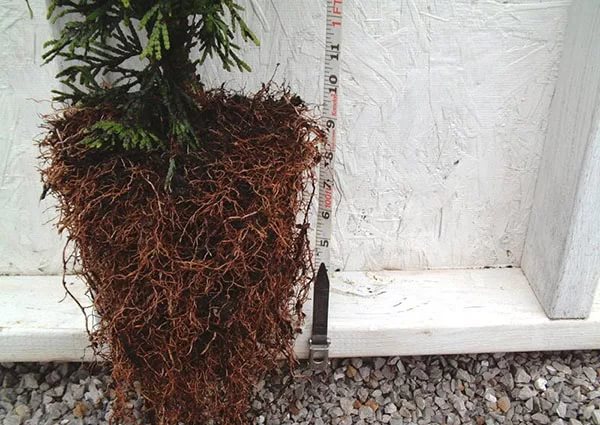
The coniferous tree of the Hoseri variety is a dwarf plant, and it reaches a height of no more than 500 mm. The crown of Hosery has a beautiful spherical shape. This variety is suitable for planting in decorative purposes in places where it is impossible to plant larger plants.
Coniferous tree of the Danika variety belongs to dwarf plants. Danica has a beautiful dense rounded crown, the diameter of which is 1 meter and the height is 80 cm. This conifer is used to decorate borders, gardens, and rocky areas.
How to properly plant thuja in the country
It is best to plant thuja in spring period time, but if you follow certain conditions planting, the process of planting a plant can be carried out in the fall.
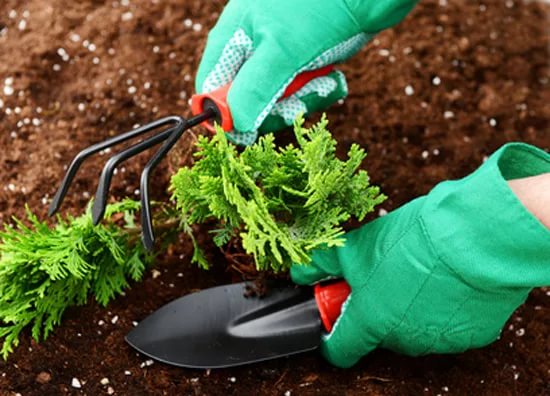
How to choose a place to plant a plant
Thuja is unpretentious plant in relation to soil type and moisture, and this is its main advantage. In order for the thuja to feel comfortable, it is necessary to choose a place well lit by the sun in the area where the plant will be planted, since the thuja is very light-loving. Thuja can grow in shady place, but then it will not be so luxurious and fluffy - thus, such a plant simply needs sunlight. Thuja may have different shape, which depends on the composition being created. Many landscape designers, when cutting a plant, give it the shape of a ball or an elongated tree.
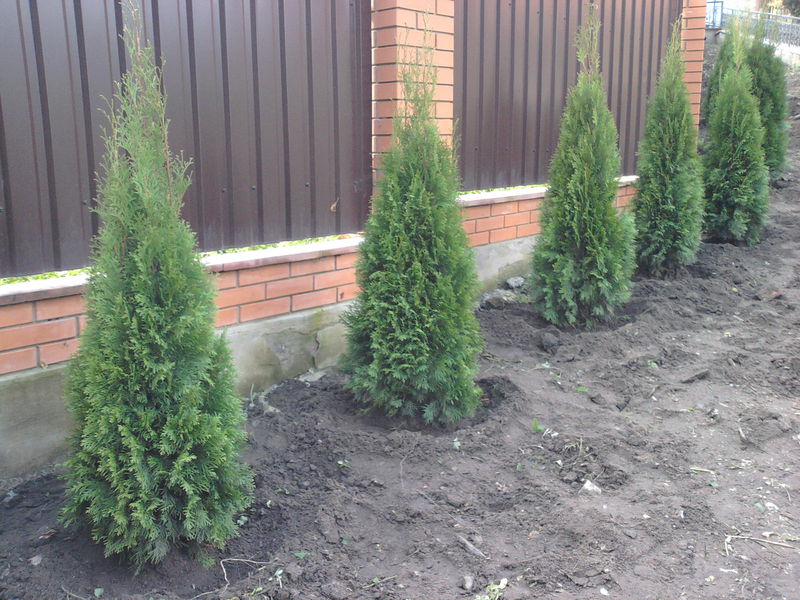
Thuja is used not only for decorative purposes. It is also popular in the field of medicine. Thuja is often called the Tree of Life, as the plant contains a large amount of beneficial essential oils.
Thuja is an unpretentious plant, but fertile and permeable soils are best suited for planting. Thuja needs enough moisture. If the plant experiences a lack of moisture, the needles will begin to turn yellow and gradually crumble. If the thuja grows in regions where winters are very cold, then the plant needs to be completely covered with snow. Thujas should be planted at a distance of at least 50 cm from each other. If plants are planted along an alley, then the distance between them should not be less than 2.5–3.5 meters.
In order for the thuja to be a true evergreen decoration of the garden and require minimal care, you need to be very careful when choosing where to plant the plant.

How to choose seedlings
To purchase a high-quality fertile seedling, you need to pay attention to its roots: they must be well closed, and the earthen ball must be quite dense. It is recommended to purchase seedlings that are in pots.
Before you begin the process of transporting the seedling, you need to wrap it in burlap. Planting a seedling should not be delayed: it is recommended to do it within 2 days.
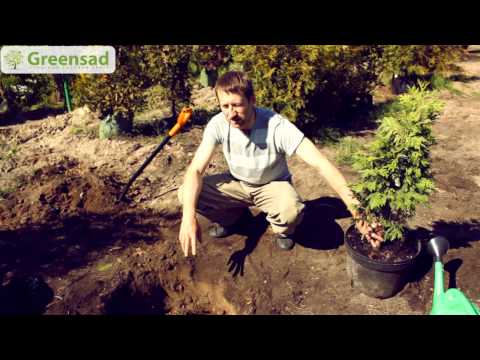
Planting methods
There are three ways to plant thuja in the country:
- 1. With the help of a seed.
- 2. Using cuttings.
- 3. Using seedlings.
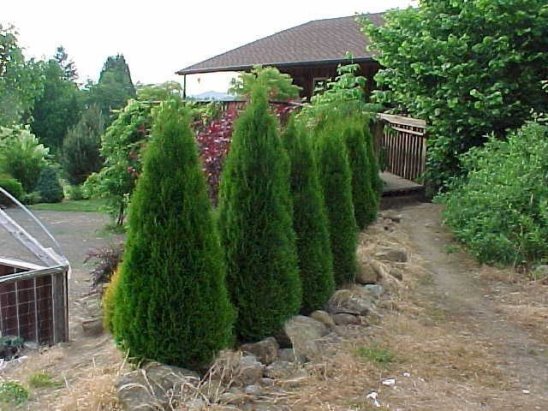
Seed method
It is important to remember that when seed method planting the plant, the parental qualities of the thuja are lost. Growing thuja at home is a rather labor-intensive and time-consuming process. To begin, the seed cones need to be carefully broken off and placed in a warm place, where they will gradually open. The seed cones of the plant have light brown color. After the cones have opened, you must choose one of two options:
- in order to save time, during the first 2–3 months, stratify the seeds and sow them;
- use the natural propagation method - that is, wait until December to plant the seeds.

Seeds must be planted in soil that has a coniferous composition. So that the pine needle seeds germinate well, optimal temperature air temperature is more than 20 degrees. During the first two weeks, the box where the seeds are located should be covered with glass, but one must not forget to periodically ventilate the seeds. It is also important not to forget about moistening the soil by spraying it. After the seeds germinate, the glass should be removed - this will happen a month from the moment of sowing. After some time, when the sprouts are well established, they need to be transplanted into separate pots. The composition of the soil in the pots should also be coniferous. Expanded clay and AVA fertilizer must be placed at the bottom of the pot. After 2–3 years, the seedling will be ready for planting in open ground.
Cuttings
To , it is necessary from young plant When 2–3 years old, cut off woody shoots in July. The length of thuja branches should not be less than 15 cm. The cutting must be cut with a piece of the main tree and placed in the root solution. Before planting the cuttings in a pot, the soil in it must be disinfected with a solution of potassium permanganate. The cutting should be planted at a depth of 1.5–3.0 cm. To maintain the moisture necessary for rooting of the thuja, it must be covered with film. When the seedlings are already strong, they need to be opened so that they get used to environment. With the onset of spring, the thuja must be moved to its main place.
Planting seedlings
In order to plant seedlings, it is necessary to choose a non-hot season. In the fall, seedlings need to be planted no later than October - that is, before the first frost, since the seedling needs time to develop. If the seedling has an open root system, then for better survival it is recommended to soak it in the root.
To plant a seedling, you need to dig a hole 75–100 cm deep; at the bottom of this hole there should be compost with black soil or peat. If the soil is very dense, it is recommended to form a drainage layer of 10 cm. Crushed stone, broken red brick, large pebbles and expanded clay are suitable for forming a drainage layer. The soil dug out of the hole should be mixed with sand in a ratio of 3 to 1. Next, you need to place the plant in the hole and cover it with soil so that a small neck trunk is visible on the surface. After this, you need to compact the roots well so that they do not break, and water generously.
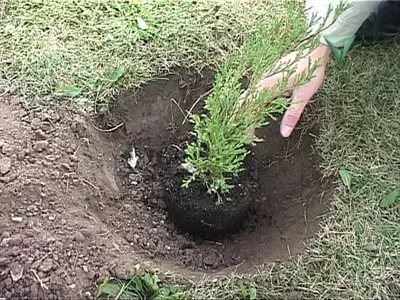
If planting is carried out in the autumn, then you immediately need to form a mulch layer of 5–7 cm. This layer should not cover the lower branches and trunk. A peat mixture with compost or pine bark can act as a mulch layer. If the thuja is planted in the spring, then it should be given a special fertilizer for coniferous plants.
Care
During hot weather and when transplanting, the tree must be watered. One tree should require 10–30 liters of water. Once every two years in the spring, thuja needs to be fed with special fertilizers.
With the onset of June, the plant should be treated with an aphid repellent. After watering, it is necessary to loosen the soil: this should be done at least once a month.
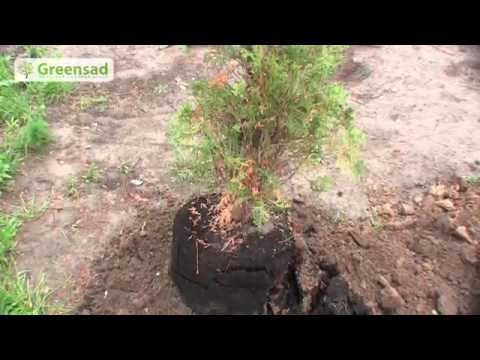
Root system structure
Root system Thuja's is compact. This means that it is small in size, the roots of the plant are located shallow in the soil, they are almost on the surface. Due to the fact that the root system of pine needles is arranged in a similar way, this crop prefers to grow and develop in loose and light soil. The root system of pine needles is branched, and therefore the roots grow in width, but not in depth. Many gardeners notice that the roots of the plant are often on the surface of the soil - in this case, hilling the trunk is necessary.

